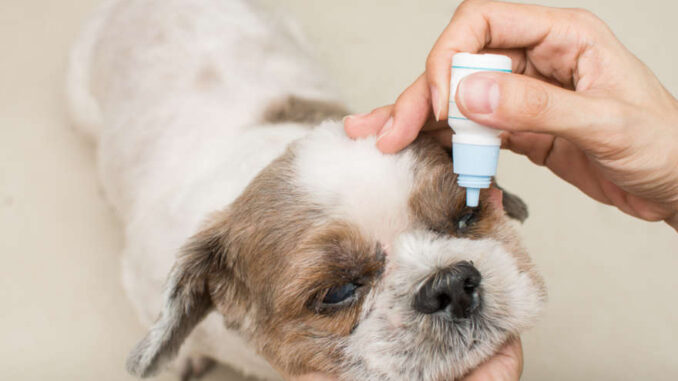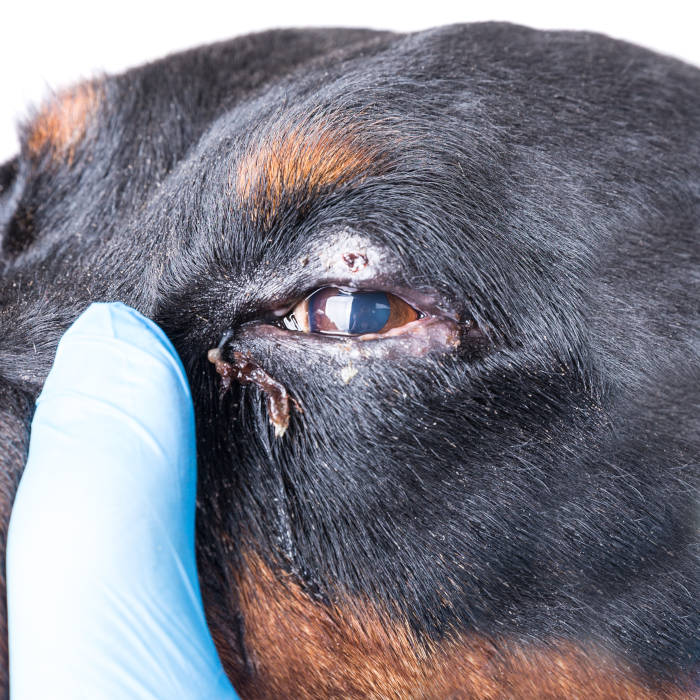
When I was in practice, I occasionally fielded calls from clients concerned because their dog had swollen eyelids. After asking about the dog’s history and symptoms, I sometimes suggested that the owner care for their furbaby at home first. In this article, I will share home remedies and discuss when to take your dog to the vet.
How do I know if I can treat my dog’s swollen eyelid at home?
There are various causes of swollen eyelids in dogs. While some conditions are mild and treatable at home, others require veterinary care to prevent further damage to the eye.
Before you apply any home remedies for a swollen eyelid, call your veterinarian. You may be able to describe your dog’s history and signs or connect via a telecall to determine if an office visit is needed. If the signs are mild, your doctor may recommend treating the condition at home.
Most of the time, dogs with swollen eyelids require a veterinary examination to diagnose the underlying condition. However, if you’re confident that irritation from a substance like dust, dirt, or soap is triggering your pal’s symptoms, you may be able to apply a home remedy.
Call your vet immediately if your dog’s condition gets worse or his eyelids don’t improve after a day or two of home care.
6 steps you can take at home to help your dog
Once you talk to your dog’s doctor and schedule your veterinary visit, you may be able to help your dog at home. Always check with the vet before you try any home remedies.
Below are some remedies that may help to alleviate your pal’s pain and eye inflammation((Eye Inflammation in Dogs. Small Door Veterinary. https://www.smalldoorvet.com/learning-center/medical/eye-inflammation-in-dogs)).
1. Gently wash the eye
If you think an irritant is causing your dog’s swollen eyelid, gently wash the eye to remove soap residue, dirt, or debris. Flushing out foreign substances can help to prevent additional inflammation and corneal abrasions.
2. Apply a warm saltwater solution
Mix a bottle of warm water with about a teaspoon of salt and gently splash it on your dog’s eye. Dab the solution with a clean cotton pad to remove excess liquid and any debris or discharge. You can also use a sterile saline eyewash. These solutions are pH-balanced for the eye and can help draw edema out of the eyelid to reduce swelling.
3. Apply a warm compress
Dampen a clean washcloth with warm water and lightly press it against your dog’s eye for 5-10 minutes. Always check the cloth’s temperature against the inside of your wrist first to make sure it’s not too hot for your furbaby. Warm compresses can help soothe irritated tissue and stimulate circulation to encourage healing.
4. Apply chamomile tea
Steep some chamomile tea and allow the liquid to cool to room temperature. Then, use a cotton ball to apply the solution to your dog’s eye. Chamomile contains chemicals known as terpenoids and flavenoids which have anti-inflammatory, antioxidant, and healing properties((Chamomile: A herbal medicine of the past with a bright future: https://www.ncbi.nlm.nih.gov/pmc/articles/PMC2995283/)).
5. Give your dog Benadryl
If you suspect your dog’s eye inflammation is caused by an allergic response, talk to your veterinarian about giving him an antihistamine such as Benadryl to reduce inflammation and itching. Your doctor can advise whether antihistamines are safe for your dog and what dosage he needs based on your pup’s breed and size/weight.
6. Use an E-collar
Swollen eyelids are often painful or itchy. Your dog may attempt to rub or scratch the area, and this can cause injury or increased swelling. By applying an e-collar, you prevent trauma to the eye and eyelid and allow the area time to heal.
Best products you can use at home
Burt’s Bees for Pets Dogs Natural Eye Wash with Saline Solution
Burt’s Bees is a staple supply in my medicine cabinet and works great when my dogs have eye irritations. This natural eye wash from Burt’s Bees is formulated to match your dog’s natural pH. The solution contains saline and is free of harsh chemicals that could further irritate the eyes. One drawback is that the bottle design makes application difficult.
Medi-First 19818 Eyewash
We kept this product in our first aid kit at the clinic, and I occasionally used it to flush debris from dog’s eyes. The saline solution is gentle and pH-balanced. It helped to clear away irritants and reduce inflammation. This product is not intended for daily use.
Supet Dog Cone Adjustable Pet Cone
We switched to Supet Dog Cones because they’re softer and lighter than traditional E-collars. The material’s flexibility is more comfortable for dogs, but it still effectively prevents them from rubbing or scratching the eye area. However, you need to carefully measure your dog’s neck to snout length to ensure the cone is deep enough. This product may not properly fit dogs with longer snouts.
Why is it important to check with my vet?
If your dog has a swollen eyelid, the first thing to do is contact your veterinarian. The condition is usually very painful for your pup and requires veterinary care. While some causes of blepharitis are fairly benign, others can lead to eye damage and/or vision problems if they don’t receive prompt treatment.
Why is my dog’s eyelid swollen? (Top Causes)
There are various causes of swollen eyelids in dogs. Your veterinarian can examine your furbaby and run diagnostic tests to determine why your precious pup has an inflamed eyelid. The most common reasons for blepharitis((Veterinary Dermatology: Blepharitis in dogs: A clinical evaluation in 102 dogs:https://onlinelibrary.wiley.com/doi/full/10.1111/vde.12736)) include:
1. Allergies
Allergic skin reactions are the top cause of swollen eyelids in dogs. Environmental allergens, food sensitivities, or insect bites can trigger the inflammatory response. With allergies, the eyelid will be puffy, reddened, and itchy. There may also be a watery discharge. https://www.shutterstock.com/image-photo/dog-eyes-infection-irritated-red-suffering-1257340312
2. Infections
Dogs can get bacterial, viral, or fungal eye infections. Of these, the most common agents are Staphylococcus and Streptococcus bacterial species((Today’s Veterinary Practice: Clinical Approach to Canine Eyelid Disease: Blepharitis:https://todaysveterinarypractice.com/ophthalmology/observations-in-ophthalmology-clinical-approach-to-canine-eyelid-disease-blepharitis/)). Dogs with eyelid infections generally have:
- Swollen, red eyelids
- Eye discharge
- Crusting
- Diffuse ulceration(chronic conditions)

Parasitic infection
The most common causes of parasitic eye infections are demodectic and sarcoptic mange. Demodicosis can be localized to the eye region in puppies under 10 months old. When mange affects mature dogs, symptoms are usually more generalized throughout the body. Signs that your dog’s eyelid swelling is caused by parasites may include redness and swelling of the eyelid, crusting, skin scaling, and hair loss. Dogs with sarcoptic mange will have extreme itching.

Dog with demodectic mange. Notice the redness and swelling around the eyelids.
Autoimmune disorders
Dogs suffering from systemic diseases that can cause autoimmune responses include Cushing’s disease, hypothyroidism, zinc-responsive dermatitis, and pemphigus-complex diseases. With these conditions, you may notice
- Eyelid inflammation
- Hair loss
- Eyelid ulceration
- Pustules
- Crusting around the eyelid(pemphigus)
- Scaling(pemphigus)
- Hyperpigmentation(pemphigus)
Neoplasia
Various neoplasias affect canine eyelids. Fortunately, most of them are locally invasive and benign. Some of the more common growths are meibomian gland tumors, melanomas, and papillomas. The swelling/growth appears on the upper eyelid more often than the lower eyelid. These tumors generally occur in older dogs(over 10 years old).
Disclaimer: This website's content is not a substitute for veterinary care. Always consult with your veterinarian for healthcare decisions. Read More.


Be the first to comment